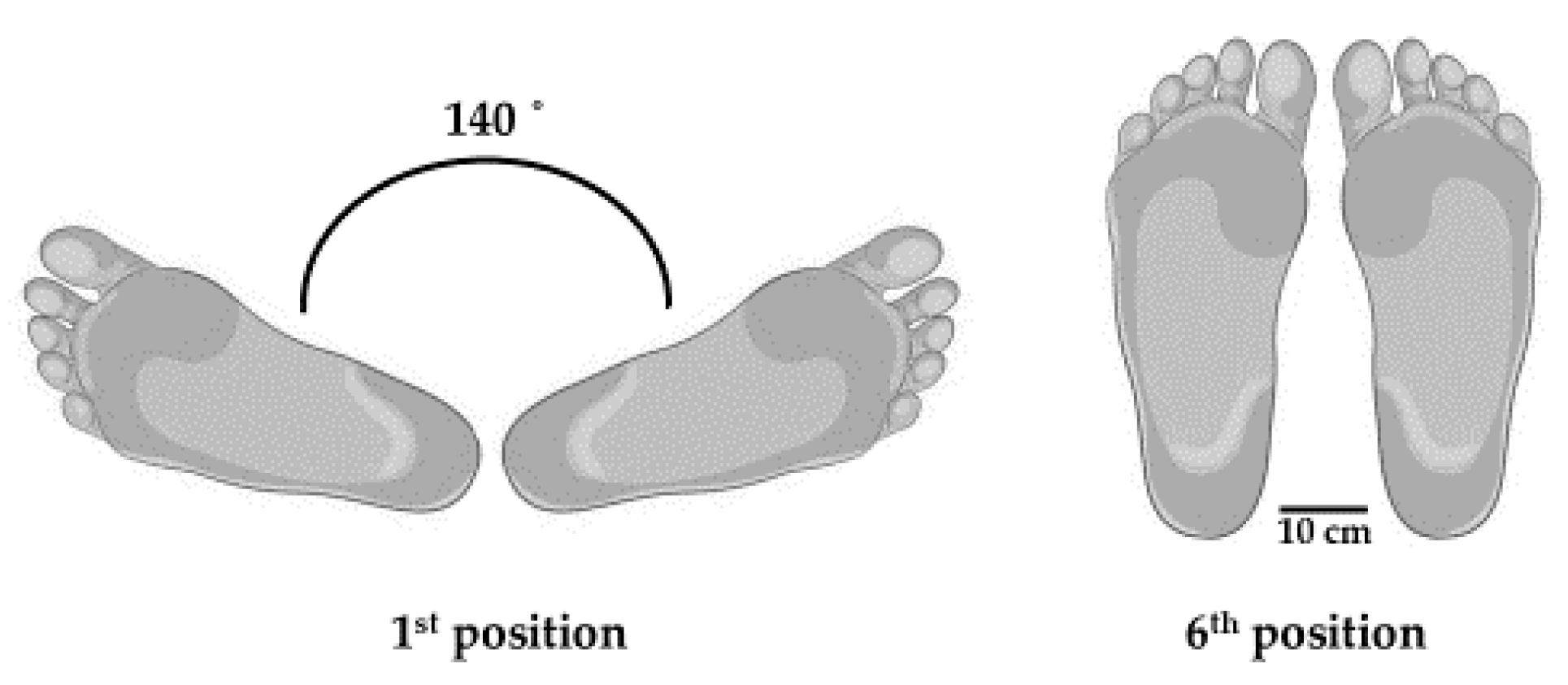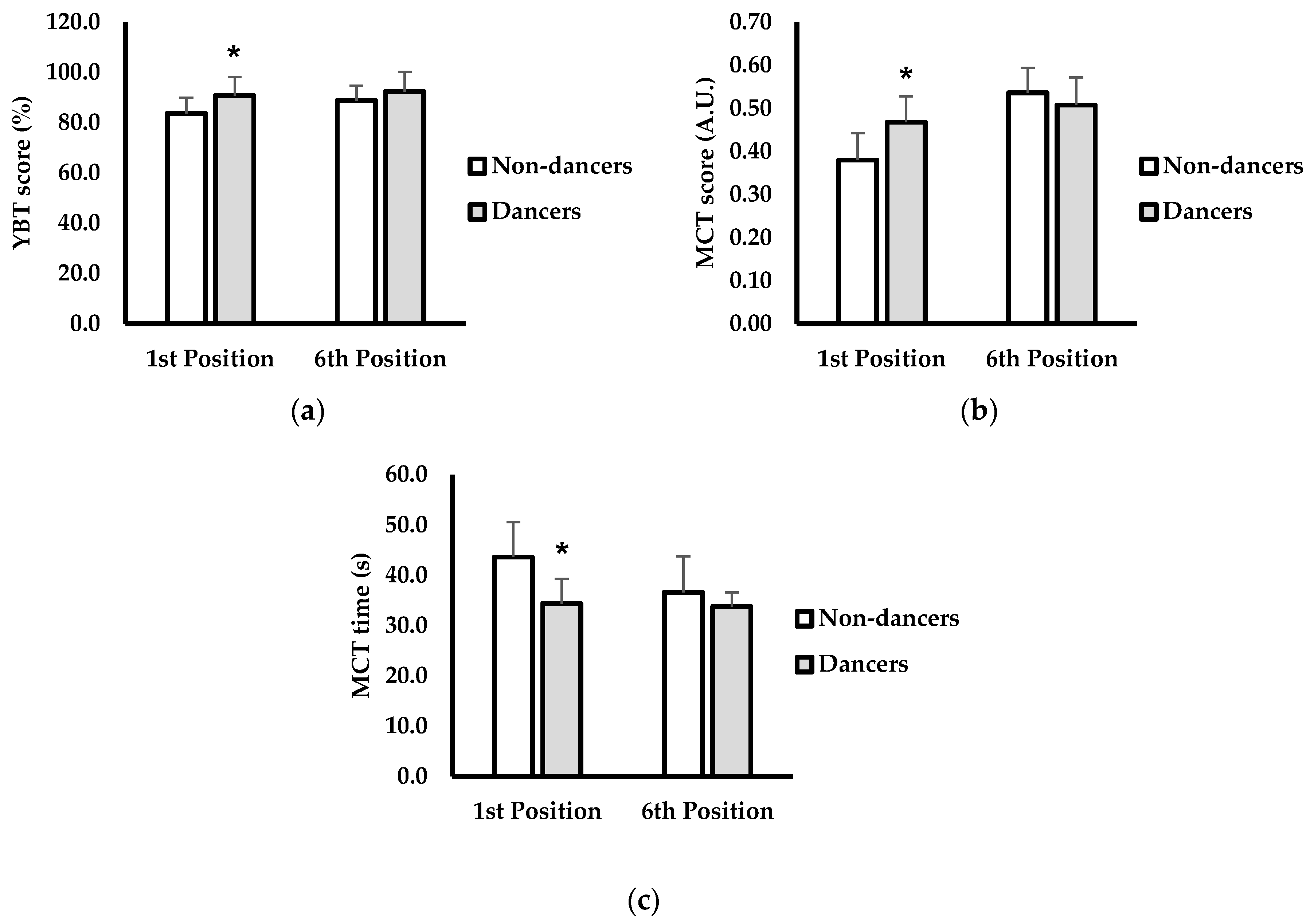Differences in Balance Ability and Motor Control between Dancers and Non-Dancers with Varying Foot Positions
Abstract
1. Introduction
2. Materials and Methods
2.1. Study Design
2.2. Participants
2.3. Y-balance Test (YBT)
2.4. Biosway Motor Control Test (MCT)
2.5. Data analysis
3. Results
4. Discussion
5. Conclusions
Author Contributions
Funding
Acknowledgments
Conflicts of Interest
References
- Pollock, A.S.; Durward, B.R.; Rowe, P.J.; Paul, J.P. What is balance? Clin. Rehabil. 2000, 14, 402–406. [Google Scholar] [CrossRef] [PubMed]
- Patton, J.L.; Pai, Y.-C.; Lee, W.A. Evaluation of a model that determines the stability limits of dynamic balance. Gait Posture 1999, 9, 38–49. [Google Scholar] [CrossRef]
- Hrysomallis, C. Balance ability and athletic performance. Sports Med. 2011, 41, 221–232. [Google Scholar] [CrossRef] [PubMed]
- Koutedakis, Y.; Jamurtas, A. The dancer as a performing athlete: Physiological considerations. Med. Probl. Perform. Artist. 2005, 20, 109–111. [Google Scholar] [CrossRef]
- Krityakiarana, W.; Jongkamonwiwat, N. Comparison of balance performance between Thai classical dancers and non-dancers. J. Dance Med. Sci. 2016, 20, 72–78. [Google Scholar] [CrossRef] [PubMed]
- Kilroy, E.A.; Crabtree, O.M.; Crosby, B.; Parker, A.; Barfield, W.R. The effect of single-leg stance on dancer and control group static balance. Int. J. Exerc. Sci. 2016, 9, 110. [Google Scholar]
- Rowley, K.M.; Jarvis, D.N.; Kurihara, T.; Chang, Y.-J.; Fietzer, A.L.; Kulig, K. Toe flexor strength, flexibility and function and flexor hallucis longus tendon morphology in dancers and non-dancers. Med. Probl. Perform. Artist. 2015, 30, 152–156. [Google Scholar] [CrossRef] [PubMed]
- Gupta, A.; Fernihough, B.; Bailey, G.; Bombeck, P.; Clarke, A.; Hopper, D. An evaluation of differences in hip external rotation strength and range of motion between female dancers and non-dancers. Br. J. Sports Med. 2004, 38, 778–783. [Google Scholar] [CrossRef] [PubMed]
- Dowse, R.A.; McGuigan, M.R.; Harrison, C. Effects of a resistance training intervention on strength, power, and performance in adolescent dancers. J. Strength Cond. Res. 2017. [Google Scholar] [CrossRef] [PubMed]
- Tekin, D.; Agopyan, A.; Baltaci, G. Balance training in modern dancers: Proprioceptive-neuromuscular training vs kinesio taping. Med. Probl. Perform. Artist. 2018, 33, 156–165. [Google Scholar] [CrossRef]
- Filipa, A.R.; Smith, T.R.; Paterno, M.V.; Ford, K.R.; Hewett, T.E. Performance on the Star Excursion Balance Test predicts functional turnout angle in pre-pubescent female dancers. J. Dance Med. Sci. 2013, 17, 165–169. [Google Scholar] [CrossRef] [PubMed]
- Lin, C.-F.; Lee, I.-J.; Liao, J.-H.; Wu, H.-W.; Su, F.-C. Comparison of postural stability between injured and uninjured ballet dancers. Am. J. Sports Med. 2011, 39, 1324–1331. [Google Scholar] [CrossRef]
- Clark, T.; Redding, E. The relationship between postural stability and dancer’s past and future lower-limb injuries. Med. Probl. Perform. Artist. 2012, 27, 197. [Google Scholar] [CrossRef]
- Casabona, A.; Leonardi, G.; Aimola, E.; La Grua, G.; Polizzi, C.M.; Cioni, M.; Valle, M.S. Specificity of foot configuration during bipedal stance in ballet dancers. Gait Posture 2016, 46, 91–97. [Google Scholar] [CrossRef] [PubMed]
- Gonell, A.C.; Romero, J.A.P.; Soler, L.M. Relationship between the Y balance test scores and soft tissue injury incidence in a soccer team. Int. J. Sports Phys. Ther. 2015, 10, 955. [Google Scholar]
- Fritz, C.O.; Morris, P.E.; Richler, J.J. Effect size estimates: Current use, calculations, and interpretation. J. Exp. Psychol. Gen. 2012, 141, 2–18. [Google Scholar] [CrossRef] [PubMed]
- Cohen, J. Statistical Power Analysis for the Behavioral Sciences, 2nd ed.; Lawrence Erlbaum Associates: Hillsdale, NJ, USA, 1988. [Google Scholar]
- Da Silveira Costa, M.S.; de Sá Ferreira, A.; Felicio, L.R. Static and dynamic balance in ballet dancers: A literature review. Fisioter. Pesqui 2013, 20, 299–305. [Google Scholar]
- Çelenk, Ç.; Marangoz, İ.; Aktuğ, Z.B.; Top, E.; Akıl, M. The effect of quadriceps femoris and hamstring muscular force on static and dynamic balance performance. Int. J. Phys. Educ. Sports Health 2015, 2, 323–325. [Google Scholar]
- Owen, G.; Cronin, J.; Gill, N.; McNair, P. Knee extensor stiffness and functional performance. Phys. Ther. Sport 2005, 6, 38–44. [Google Scholar] [CrossRef]
- Phillips, C. Stability in dance training. J. Dance Med. Sci. 2005, 9, 24–28. [Google Scholar]
- Ambegaonkar, J.P.; Caswell, S.V.; Winchester, J.B.; Shimokochi, Y.; Cortes, N.; Caswell, A.M. Balance comparisons between female dancers and active nondancers. Res. Q. Exerc. Sport 2013, 84, 24–29. [Google Scholar] [CrossRef]
- Golomer, E.; Dupui, P.; Séréni, P.; Monod, H. The contribution of vision in dynamic spontaneous sways of male classical dancers according to student or professional level. J. Physiol. Paris 1999, 93, 233–237. [Google Scholar] [CrossRef]
- Iwakura, M.; Okura, K.; Shibata, K.; Kawagoshi, A.; Sugawara, K.; Takahashi, H.; Shioya, T. Relationship between balance and physical activity measured by an activity monitor in elderly COPD patients. Int. J. Chronic Obstr. Pulm. Dis. 2016, 11, 1505. [Google Scholar] [CrossRef] [PubMed]
- Ferreira, M.L.; Sherrington, C.; Smith, K.; Carswell, P.; Bell, R.; Bell, M.; Nascimento, D.P.; Pereira, L.S.M.; Vardon, P. Physical activity improves strength, balance and endurance in adults aged 40–65 years: A systematic review. J. Physiother. 2012, 58, 145–156. [Google Scholar] [CrossRef]
- Keetch, K.M.; Schmidt, R.A.; Lee, T.D.; Young, D.E. Especial skills: Their emergence with massive amounts of practice. J. Exp. Psychol. Hum. Percept. Perform. 2005, 31, 970. [Google Scholar] [CrossRef] [PubMed]
- Plisky, P.J.; Rauh, M.J.; Kaminski, T.W.; Underwood, F.B. Star Excursion Balance Test as a predictor of lower extremity injury in high school basketball players. J. Orthop. Sports Phys. Ther. 2006, 36, 911–919. [Google Scholar] [CrossRef]
- Olivier, B.; Stewart, A.; Olorunju, S.; McKinon, W. Static and dynamic balance ability, lumbo-pelvic movement control and injury incidence in cricket pace bowlers. J. Sci. Med. Sport 2015, 18, 19–25. [Google Scholar] [CrossRef]
- Negus, V.; Hopper, D.; Briffa, N.K. Associations between turnout and lower extremity injuries in classical ballet dancers. J. Orthop. Sports Phys. Ther. 2005, 35, 307–318. [Google Scholar] [CrossRef]
- Norton, K.; Olds, T.; Olive, S.; Craig, N. Anthropometry and sports performance. In Anthropometrica: A Textbook of Body Measurement for Sports and Health Courses; Norton, K., Olds, T., Eds.; UNSW Press: Radwick, Australia, 1996; pp. 287–364. [Google Scholar]
- Handrigan, G.; Hue, O.; Simoneau, M.; Corbeil, P.; Marceau, P.; Marceau, S.; Tremblay, A.; Teasdale, N. Weight loss and muscular strength affect static balance control. Int. J. Obes. 2010, 34, 936–942. [Google Scholar] [CrossRef] [PubMed]
- Fusco, A.; Giancotti, G.F.; Fuchs, P.X.; Wagner, H.; da Silva, R.A.; Cortis, C. Y balance test: Are we doing it right? J. Sci. Med. Sport 2020, 23, 194–199. [Google Scholar] [CrossRef]
- Ambegaonkar, J.P.; Mettinger, L.M.; Caswell, S.V.; Burtt, A.; Cortes, N. Relationships between core endurance, hip strength, and balance in collegiate female athletes. Int. J. Sports Phys. Ther. 2014, 9, 604. [Google Scholar] [PubMed]


| Characteristic | Non-Dancer (n = 9) | Dancer (n = 11) |
|---|---|---|
| Age (yr) | 19.5 ± 0.8 | 21.2 ± 0.7 * |
| Height (cm) | 163.2 ± 3.9 | 165.3 ± 3.9 |
| Body mass (kg) | 64.3 ± 8.1 | 58.1 ± 6.3 * |
| Lower limb length (cm) | 88.2 ± 4.54 | 85.9 ± 4.8 |
© 2020 by the authors. Licensee MDPI, Basel, Switzerland. This article is an open access article distributed under the terms and conditions of the Creative Commons Attribution (CC BY) license (http://creativecommons.org/licenses/by/4.0/).
Share and Cite
Harmon, B.V.; Reed, A.N.; Rogers, R.R.; Marshall, M.R.; Pederson, J.A.; Williams, T.D.; Ballmann, C.G. Differences in Balance Ability and Motor Control between Dancers and Non-Dancers with Varying Foot Positions. J. Funct. Morphol. Kinesiol. 2020, 5, 54. https://doi.org/10.3390/jfmk5030054
Harmon BV, Reed AN, Rogers RR, Marshall MR, Pederson JA, Williams TD, Ballmann CG. Differences in Balance Ability and Motor Control between Dancers and Non-Dancers with Varying Foot Positions. Journal of Functional Morphology and Kinesiology. 2020; 5(3):54. https://doi.org/10.3390/jfmk5030054
Chicago/Turabian StyleHarmon, Brooke V., Andrea N. Reed, Rebecca R. Rogers, Mallory R. Marshall, Joseph A. Pederson, Tyler D. Williams, and Christopher G. Ballmann. 2020. "Differences in Balance Ability and Motor Control between Dancers and Non-Dancers with Varying Foot Positions" Journal of Functional Morphology and Kinesiology 5, no. 3: 54. https://doi.org/10.3390/jfmk5030054
APA StyleHarmon, B. V., Reed, A. N., Rogers, R. R., Marshall, M. R., Pederson, J. A., Williams, T. D., & Ballmann, C. G. (2020). Differences in Balance Ability and Motor Control between Dancers and Non-Dancers with Varying Foot Positions. Journal of Functional Morphology and Kinesiology, 5(3), 54. https://doi.org/10.3390/jfmk5030054







